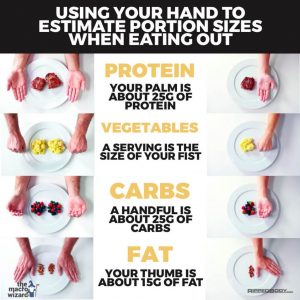One of the BEST ways to improve your health is to food track because there’s an immediate & natural accountability & improvement in food quality when tracking.
If you are SERIOUS about your goals, it’s best to get a personalized target so you have something to aim for. I can help you – just reach out!
Here are some macro counting tips…
Goal: Shoot for 10% either side of each macro target for the day, 90% of the time (as long as the other 10% of the time isn’t binge eating)..
Starchy Carbs
Here are some examples of common foods…
- Raw Potatoes ~15g-20g carbs per 100g wgt
- Sweet potatoes, ~20-25g per 100g wgt
- Dried Rice (works for most dried pasta too) ~70g of carbs per 100g wgt
Carbs —>Fruit
- Consider one ‘medium’ sized piece of fruit (an apple, a banana, a pear, an orange, etc.) to be 25g of carbs
- Other things like berries, melon, etc —>Weigh them once & look them up
Carbs —>Vegetables
AIM FOR 600g OF FIBROUS VEGGIES PER DAY
- Count the carbs in starchy vegetables (eg. carrots, peas, corn, potatoes, parsnips) because energy content is high & fiber content per gram of carbs is low
- Don’t fuss about counting the carbs in any leafy, green vegetables & fibrous veggies because they aren’t very energy dense & it’s tough to eat so many that it makes a significant impact on intake
Protein
Here are some examples:
- Uncooked beef/ chicken/ pork/ lamb/ fish 100g = ~20-25g protein
- One large egg = ~8g protein 5g fat
- Egg whites = ~4g protein
Fat content in meat adds so be mindful of your fat macro budget for the day.
Here are the leanest protein sources…
- Chicken breast (skinless)
- some red meat
- fish
- egg
- protein shakes <—limit to one meal per day
- Skimmed milk & other, low-fat dairy
Fat
- In contrast to vegetables, fat is highly energy dense…Generally 1g of weight = 1g fat = 9 Cal
- Since energy content is high count the fat in everything
Eating Out
Use your hand to estimate (one hand for women – use two hands for men)
- palm size is protein serving

- fist size is starchy carb
- open palm is serving of veg
- end of thumb is fat serving
- Try to replicate what you eat at home as much as possible. Visual memory should help here with portion sizes, choices.
- Exaggerate the numbers in the meal, especially the fat count.
- ‘De-construct’ a meal into it’s components and log individually if you can’t find a food in your food tracker that seems reasonable.
- *Adjust the rest of the day around your meals out.
Macro tracking has helped me maintain my weight since high school – I have NOT macro tracked my entire life – I’ve used the education I gained to adjust serving sizes & eat for my metabolism.
If you want more direction, I’d love to help! You can start the conversation by filling in this questionnaire.
Happy food tracking!




